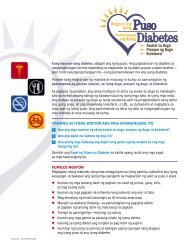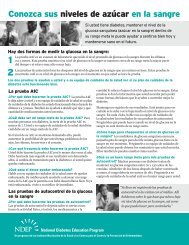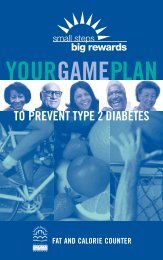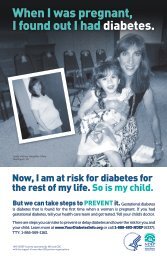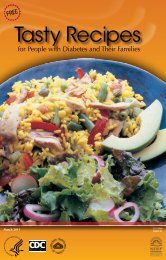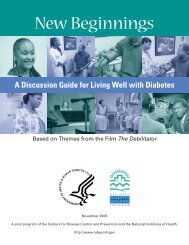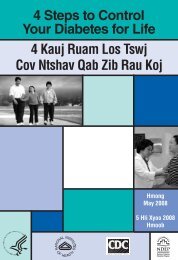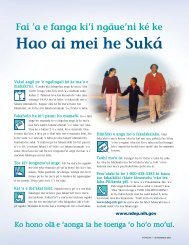Power to Prevent - National Diabetes Education Program - National ...
Power to Prevent - National Diabetes Education Program - National ...
Power to Prevent - National Diabetes Education Program - National ...
Create successful ePaper yourself
Turn your PDF publications into a flip-book with our unique Google optimized e-Paper software.
Pre–Session 6 Questionnaire<br />
Hand out the Pre–Session 6 Questionnaire (one copy per participant). Based on your previous<br />
experience, either read each question and answer choice aloud <strong>to</strong> the group or let the group work in<br />
silence. Suggest that if participants would like assistance because they have forgotten their reading<br />
glasses or for some other reason, you (or your helpers) can assist them. Remind participants <strong>to</strong> write<br />
their names (or their initials with their day and month of birth) on the questionnaires and <strong>to</strong> hand<br />
them in <strong>to</strong> you. Be sure <strong>to</strong> collect all questionnaires so that you can pho<strong>to</strong>copy them and return<br />
them <strong>to</strong> participants at a future session.<br />
Discussion Points<br />
Say: “The goal for <strong>to</strong>day is <strong>to</strong> help everyone gain a better understanding of diabetes and its health risks and<br />
how <strong>to</strong> prevent or manage the disease. I’m going <strong>to</strong> give you some facts about diabetes. Let’s refresh<br />
our memories from Session 1. What is diabetes?”<br />
After listening <strong>to</strong> the responses from group members, use the explanations below <strong>to</strong> fll in any<br />
points that were missed.<br />
<strong>Diabetes</strong> results when the body cannot use blood glucose (sugar) as energy because the body has<br />
<strong>to</strong>o little insulin or is unable <strong>to</strong> use the insulin it produces.<br />
<strong>Diabetes</strong> is a disease that impairs the body’s ability <strong>to</strong> use food. The hormone insulin, which is<br />
made in the pancreas, helps the body <strong>to</strong> change food in<strong>to</strong> energy. In people with diabetes, either<br />
the pancreas does not make insulin, or the body cannot use insulin properly. Without insulin,<br />
glucose (or sugar)—the body’s main energy source—builds up in the blood.<br />
Types of diabetes and the risk fac<strong>to</strong>rs for diabetes were covered in Session . Review them briefy <strong>to</strong><br />
refresh participants’ memories.<br />
Additional Information on <strong>Diabetes</strong><br />
Say: “Can anyone name some of the signs and symp<strong>to</strong>ms of diabetes?”<br />
List answers on a fipchart, and make sure that the following items are mentioned:<br />
Frequent urination<br />
Excessive thirst<br />
Blurred vision<br />
Dizziness or lightheadedness<br />
Tingling or numbness in hands and feet<br />
Tiredness<br />
Sores that are slow <strong>to</strong> heal<br />
More infections than usual<br />
Make sure that you point out that some people with diabetes have NO symp<strong>to</strong>ms.<br />
Say: “Can anyone name some of the complications of diabetes that can be avoided with good control?”<br />
NDEP <strong>Power</strong> <strong>to</strong> <strong>Prevent</strong> Session 6 5



